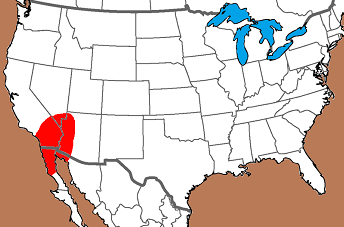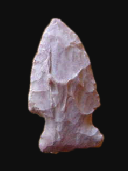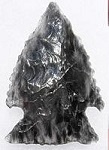Outline is Representative of Size and Shape:

Name Details:
Identified By: Malcolm Rogers
Named For: Amargosa Complex
Date Identified: 1939
Type Site:
Identified By: Malcolm Rogers
Named For: Amargosa Complex
Date Identified: 1939
Type Site:
Point Validity:
Cultural type
This type has many professional references to Amargosa (Elko Series). This type includes a corner notch, and stemmed variation. They are commonly referred to as the culture that used them more than a specific type.
This type has many professional references to Amargosa (Elko Series). This type includes a corner notch, and stemmed variation. They are commonly referred to as the culture that used them more than a specific type.
Amargosa Corner Notch
(Elko Series)Cluster: Elko Corner Notch Cluster
Description of Physical Characteristics and Flaking Pattern:
This is a small to medium triangular corner notched point with a flattened to elliptical cross section. The blade may range from slightly excurvate to straight. Blades are commonly finely serrated. The shoulders are barbed, with the barbs terminating at a sharp point. The tips of the barbs are wider than the basal ears. Diagonal notches enter the blade from the corner and are generally deep and narrow. The stem is expanding with a straight to slightly convex base. This point generally has a random flaking pattern, but may vary to a parallel oblique pattern.
Size Measurements:
Total Length - 29 to 42 mm (average 32 mm), Stem Length - 5 to 11 mm, Blade Width - 16 to 23 mm (average 18 mm), Neck Width - 12 to 20 mm, Basal Width - 13 to 22 mm, Thickness 5 to 7 mm
Total Length - 29 to 42 mm (average 32 mm), Stem Length - 5 to 11 mm, Blade Width - 16 to 23 mm (average 18 mm), Neck Width - 12 to 20 mm, Basal Width - 13 to 22 mm, Thickness 5 to 7 mm
Commonly Utilized Material:
Additional Comments:
These points are thought to have evolved from the Pinto type. The Amargosa Complex 1-3 transitioned into the Basketmaker III and Pueblo II periods. These points marked the transition from darts to arrow technology (Rogers, 1966).
This point may not represent a true type but may be represent the Elko type points that were utilized by the Amargosa Complex 1-3. However, there are many professional references to Amargosa (Elko Series). There are both stemmed and corner notch variants to the Amargosa type.
These points are thought to have evolved from the Pinto type. The Amargosa Complex 1-3 transitioned into the Basketmaker III and Pueblo II periods. These points marked the transition from darts to arrow technology (Rogers, 1966).
This point may not represent a true type but may be represent the Elko type points that were utilized by the Amargosa Complex 1-3. However, there are many professional references to Amargosa (Elko Series). There are both stemmed and corner notch variants to the Amargosa type.
Distribution:

Distribution Comments:
This point is found in southern California, southern Nevada, northern Baja California, and western Arizona in area associated with Amargosa Complex 1-3 regions.
This point is found in southern California, southern Nevada, northern Baja California, and western Arizona in area associated with Amargosa Complex 1-3 regions.
Age / Periods:
Date: 3,000 - 2,000 B.P.
Cultural Period: Transitional Archaic
Glacial Period: Neoglacial to Roman Warm
Culture: Amargosa Culture
Date: 3,000 - 2,000 B.P.
Cultural Period: Transitional Archaic
Glacial Period: Neoglacial to Roman Warm
Culture: Amargosa Culture
Age Details:


